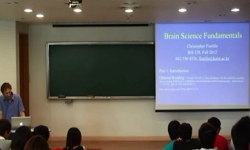This paper attempts to provide a well-founded und more elaborate "answers" to the following questions often asked by practicing interpreters: (1) Between AB (L1-L2) and BA (L2-L1) interpretation, which one is more difficult? (2) What competencies are ...
http://chineseinput.net/에서 pinyin(병음)방식으로 중국어를 변환할 수 있습니다.
변환된 중국어를 복사하여 사용하시면 됩니다.
- 中文 을 입력하시려면 zhongwen을 입력하시고 space를누르시면됩니다.
- 北京 을 입력하시려면 beijing을 입력하시고 space를 누르시면 됩니다.

통역에 대한 세 가지 질문 - 신경심리학적 관점에서 - = Three Questions about Interpreting: A Neuropsychological Review on Interpreting
한글로보기https://www.riss.kr/link?id=A106337830
-
저자
정혜연 (한국외국어대학교)
- 발행기관
- 학술지명
- 권호사항
-
발행연도
2019
-
작성언어
Korean
-
주제어
동시통역 ; 두뇌 ; 신경심리학 ; 주의 ; AB통역 ; simultaneous interpreting ; brain ; neuropsychology ; attention ; forward translation
-
등재정보
KCI등재
-
자료형태
학술저널
-
수록면
233-261(29쪽)
-
KCI 피인용횟수
0
- DOI식별코드
- 제공처
- 소장기관
-
0
상세조회 -
0
다운로드
부가정보
다국어 초록 (Multilingual Abstract)
This paper attempts to provide a well-founded und more elaborate "answers" to the following questions often asked by practicing interpreters: (1) Between AB (L1-L2) and BA (L2-L1) interpretation, which one is more difficult? (2) What competencies are necessary for simultaneous interpretation (SI)? (3) Why is it particularly difficult to interpret numbers? To address these questions, the results of approximately 20 years of neuropsychological research on the topic of "interpretation" were analyzed from the practitioner’s perspective. The findings were as follows. (1) There are no differences in severity between L1-L2 and L2-L1 per se; however, the L1-L2 balance and the interpreter’s training determine the degree of difficulty associated with interpretation. The L2-L1 initially appears easier for the majority, as verbalization in the native language is smoother. However, well-trained interpreters with balanced bilingual competence find L1-L2 easier, especially as the receptive language might play a more decisive role, according to the aphasia study of Byng et al.
(1982). (2) SI is, most of all, an “art” of attentional division and creation of primary semantic memory. The more training a simultaneous interpreter obtains, the stronger is the change associated with their anterior cingulate cortex (ACC) and the inferior parietal lobule (IPL). These brain regions are implicated in selective attention and creation of primary semantic memory, respectively. (3) The difficulty of interpreting numbers has little to do with the mathematical competence of the interpreters. It depends substantially on the ability to develop phonological memories during the formation of semantic memories as well as maintenance of these phonological memories in their original form without integration into a more abstract semantic memory. This type of competence is related to attention control as well.
참고문헌 (Reference)
1 Lundy-Ekman, L., "신경과학(Neuroscience)" 정담미디어 2009
2 Bear, M., "신경과학(Neuroscience (3/e))" 바이오메디북 2009
3 Hervais-Adelman, A., "fMRI of simultaneous interpretation reveals the neural basis of extreme language control" 25 (25): 4727-4739, 2015
4 Kurz, I., "Watching the brain at work - an exploratory study of EEG changes during simultaneous interpreting" 6 : 3-16, 1995
5 García, A. M., "Translating with an Injured Brain : Neurolinguistic Aspects of Translation as Revealed by Bilinguals with Cerebral Lesions" 60 (60): 113-134, 2015
6 Rinne, J. O., "The translating brain" 294 (294): 85-88, 2000
7 Klein, D., "The neural substrates underlying word generation — a bilingual functional-imaging study" 92 (92): 2899-2903, 1995
8 Wagner, R.K., "The nature of phonological processing and its causal role in the acquisition of reading skills" 101 : 192-212, 1987
9 Almairac, F., "The left inferior fronto-occipital fasciculus subserves language semantics: a multilevel lesion study" 220 : 1983-1995, 2014
10 Hickok, G., "The functional neuroanatomy of language" 6 (6): 121-143, 2009
1 Lundy-Ekman, L., "신경과학(Neuroscience)" 정담미디어 2009
2 Bear, M., "신경과학(Neuroscience (3/e))" 바이오메디북 2009
3 Hervais-Adelman, A., "fMRI of simultaneous interpretation reveals the neural basis of extreme language control" 25 (25): 4727-4739, 2015
4 Kurz, I., "Watching the brain at work - an exploratory study of EEG changes during simultaneous interpreting" 6 : 3-16, 1995
5 García, A. M., "Translating with an Injured Brain : Neurolinguistic Aspects of Translation as Revealed by Bilinguals with Cerebral Lesions" 60 (60): 113-134, 2015
6 Rinne, J. O., "The translating brain" 294 (294): 85-88, 2000
7 Klein, D., "The neural substrates underlying word generation — a bilingual functional-imaging study" 92 (92): 2899-2903, 1995
8 Wagner, R.K., "The nature of phonological processing and its causal role in the acquisition of reading skills" 101 : 192-212, 1987
9 Almairac, F., "The left inferior fronto-occipital fasciculus subserves language semantics: a multilevel lesion study" 220 : 1983-1995, 2014
10 Hickok, G., "The functional neuroanatomy of language" 6 (6): 121-143, 2009
11 Albert, M.L, "The Bilingual Brain" Academic Press 1978
12 Koshkin, R., "Testing the efforts model of simultaneous interpreting: An ERP study" 13 (13): 1-18, 2018
13 Zatorre R.J., "Spectral and temporal processing in human auditory cortex" 11 : 946-953, 2001
14 Elmer, S., "Simultaneous interpreters as a model for neuronal adaptation in the domain of language processing" 1317 : 147-156, 2010
15 Fridrikssona, J., "Revealing the dual streams of speech processing" 113 (113): 15108-15113, 2016
16 Cowan, N., "Processing limits of selective attention and working memory" 5 (5): 117-146, 2000
17 Elmer, S., "Processing demands upon cognitive, linguistic and articulatory functions promote grey matter plasticity in the adult multilingual brain: insights from simultaneous interpreters" 54 : 179-189, 2014
18 Aglioti, S, "Paradoxical selective recovery in a bilingual aphasic following subcortial lesions" 4 : 1359-1362, 1993
19 Hickok, G., "Opinion - the cortical organization of speech processing" 8 : 393-402, 2007
20 Kotz, S. A., "Non-motor basal ganglia functions: a review and proposal for a model of sensory predictability in auditory language perception" 45 (45): 982-990, 2009
21 Jeong H,, "Neural correlates of simultaneous interpretation: The role of expertise and language proficiency" 171-172, 2014
22 Huth, A. G., "Natural speech reveals the semantic maps that tile human cerebral cortex" 532 : 453-472, 2017
23 Proverbio, A. M., "Language switching mechanisms in simultaneous interpreters: an ERP study" 42 : 1636-1656, 2004
24 Crinion J., "Language control in the bilingual brain" 312 : 1537-1540, 2006
25 Seleskovitch, D., "Language Interpretation and Communication" 1978
26 Proverbio, A. M., "Inferring native language from early bio-electrical activity" 80 : 52-63, 2008
27 Tommola, J., "Images of shadowing and interpreting" 5 (5): 147-167, 2000
28 Proverbio, A.M., "Hemispheric Asymmetry for Language Processing and Lateral Preference in Simultaneous Interpreters" 2 (2): 12-17, 2011
29 Paradis, M., "Handbook of Neuropsychology. Vol. 2" Elsevier 117-140, 1989
30 Muñoz, E., "Grounding Translation and Interpreting in the Brain: What has been, can be and must be done" 27 (27): 483-509, 2019
31 Wu, Y, "Google’s Neural Machine Translation System: Bridging the Gap between Human and Machine Translation"
32 "Golestani et al. (in preparation). Hervais-Adelman et al. (2011). 언급"
33 Chein, J. M., "Functional heterogeneity within Broca’s area during verbal working memory" 77 : 635-639, 2002
34 Elmer, S., "Functional Connetivity in the Left dorsal stream facilitates Simultaneous Language Translation: An EEG Study" 10 (10): 1-9, 2016
35 Saint-Cyr, J. A., "Frontal-striatal circuit functions: context, sequence, and consequence" 9 (9): 103-127, 2003
36 Hervais-Adelman, A., "Executive control of language in the bilingual brain" 2 (2): 1-8, 2011
37 Faustmann, A., "Event-Related Brain Potentials Elicited by Semantic and Syntactic Anomalies during Auditory Sentence Processing" 16 : 708-725, 2005
38 Schmitt, B. M., "Electrophysiological estimates of the time course of semantic and phonological encoding during implicit picture naming" 37 : 473-484, 2000
39 Elmer, S., "Differential language expertise related to white matter architecture in regions subserving sensory-motor coupling, articulation and interhemispheric transfer" 32 : 2064-2074, 2011
40 Hervais-Adelman, A., "Cortical thickness increases after simultaneous interpretation training" 98 : 212-219, 2017
41 Luk, G., "Cognitive control for language switching in bilinguals: a quantitative meta-analysis of functional neuroimaging studies" 27 : 1479-1488, 2012
42 Elmer, S., "Broca Pars Triangularis Constitutes a “Hub” of the Language-Control Network during Simultaneous Language Translation" 10 (10): 1-13, 2016
43 García, A. M., "Brain activity during translation : A review of the neuroimaging evidence as a testing ground for clinically-based hypotheses" 26 : 370-383, 2013
44 Lenneberg, E. H., "Biologische Grundlagen der Sprache (original title: Biological Foundations of Language)" Suhrkamp 1977
45 Byng, S., "Bilingual biscriptal deep dyslexia" 36 (36): 417-433, 1984
46 Jost, L. B., "Behavioral and electrophysiological signatures of word translation processes" 109 : 245-254, 2018
47 Vaswani, A, "Attention is all you need"
48 Fabbro, F., "Aspects of Bilingual Aphasia" Pergamon 139-176, 1995
49 Paradis, M., "Alternate antagonism with paradoxical translation behavior in two bilingual aphasic patients" 15 : 55-69, 1982
50 Mutschler, I., "A rapid sound-action association effect in human insular cortex" (2) : e259-, 2007
51 Glasser, M., "A multi-modal parcellation of human cerebral cortex" 536 : 171-178, 2016
동일학술지(권/호) 다른 논문
-
신경망기계번역의 객관적 평가를 위한 예비연구: 자동평가와 수동평가의 균형점
- 한국외국어대학교 통번역연구소
- 이준호
- 2019
- KCI등재
-
소통적 통역 역량에 관한 연구: 연설문의 명제적 발화 및 대인적 발화 의도를 중심으로
- 한국외국어대학교 통번역연구소
- 진실희
- 2019
- KCI등재
-
영화 자막 중역(重譯)의 변이 현상 - 『언터처블: 1%의 우정』 사례 분석
- 한국외국어대학교 통번역연구소
- 남윤지
- 2019
- KCI등재
-
사법통역 제도화에서 전문화로 - 사법통역인과 사법통역인 선정 담당자에 대한 설문조사를 중심으로
- 한국외국어대학교 통번역연구소
- 이유진
- 2019
- KCI등재
분석정보
인용정보 인용지수 설명보기
학술지 이력
| 연월일 | 이력구분 | 이력상세 | 등재구분 |
|---|---|---|---|
| 2026 | 평가예정 | 재인증평가 신청대상 (재인증) | |
| 2020-01-01 | 평가 | 등재학술지 유지 (재인증) |  |
| 2017-01-01 | 평가 | 등재학술지 유지 (계속평가) |  |
| 2013-01-01 | 평가 | 등재 1차 FAIL (등재유지) |  |
| 2010-06-17 | 학회명변경 | 한글명 : 통역번역연구소 -> 통번역연구소영문명 : Interpretation & Translation Institute -> Interpreting and Translation Research Institute |  |
| 2010-01-01 | 평가 | 등재학술지 선정 (등재후보2차) |  |
| 2009-05-21 | 학회명변경 | 한글명 : 통역번역연구소 -> 통번역연구소영문명 : Interpretation & Translation Institute -> Interpreting and Translation Institute |  |
| 2009-01-01 | 평가 | 등재후보 1차 PASS (등재후보1차) |  |
| 2007-01-01 | 평가 | 등재후보학술지 선정 (신규평가) |  |
| 2006-09-01 | 학술지명변경 | 외국어명 : journal of interpretation & translation institute. -> Interpreting and Translation Studies |
학술지 인용정보
| 기준연도 | WOS-KCI 통합IF(2년) | KCIF(2년) | KCIF(3년) |
|---|---|---|---|
| 2016 | 0.82 | 0.82 | 0.62 |
| KCIF(4년) | KCIF(5년) | 중심성지수(3년) | 즉시성지수 |
| 0.54 | 0.5 | 0.941 | 0.13 |




 eArticle
eArticle







